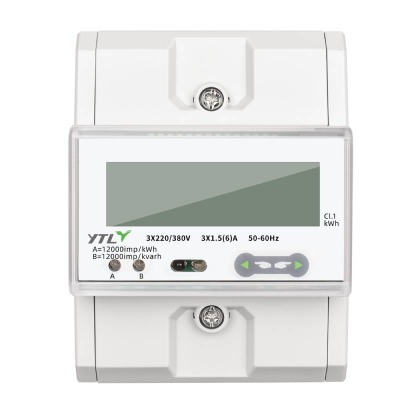Three phase energy meter is primarily used for industrial and large users' electricity meter.Everyone also possesses a basic understanding of how they work.There are many types of energy meter that can be divided into three phase energy meter , and single phase energy meter based on the power supply type. Today, we will focus on analyzing the different types of three phase energy meter.
Three phase energy meter can be divided into three categories: Three phase three wire energy meter, high voltage three phase four wire energy meter, and low voltage three phase four wire energy meter. Low voltage three phase four wire energy meter
1.Three phase three wire energy meter
Three phase energy meter has common voltage specifications of 3x100V. The voltage between phases a, b, and c is 100V each, and the current specification is 1.5 (6)A, etc. The accuracy is 0.5, 0.2. There are two class of this device, and it is used to measure the power consumption of triangles. Three phase three wire energy meter do not have a neutral line. When installed, they are connected to two current transformers, and voltage sampling is typically applied through a pt (potential transformer) for connection. They are commonly used in high voltage cabinets, industrial parks, power stations, substations, and checkpoint meter, among other places.
2. High voltage three phase four wire energy meter
The voltage specifications for high voltage three phase energy meter is 3x57.7/100V,which means that the phase voltage is 57.7V and the line voltage is 100V. The current specifications are as follows: 1.5 (6) A, 0.3 (1.2) A, etc., with an accuracy 0.5 and 0.2. It is used for measuring the power of a star connection. When installed, it connects to three current transformers, and voltage sampling is typically applied at the pt connection. This method is widely utilized in high voltage cabinets, industrial parks, power stations, substations, and checkpoint meter, among other applications.
3. Low voltage three phase four wire indirect energy meter
The voltage specifications for low voltage indirectly three phase energy meter is 3x220/380V, which indicates that the phase voltage is 220V and the line voltage is 380V. The current specifications are mostly 1.5 (6) A, with an accuracy class is 0.5, and it is used for measuring the power of a star connection. When installed, it connects to three current transformers and the voltage sampling is directly linked to a three phase electricity meter. It is suitable for commercial buildings, large office buildings, factories, schools, and other large power users' locations. A low voltage three phase four wire mutual inductance energy meter will be used in circuits where the current on the low voltage side exceeds 100A.
4. Low voltage three phase four wire direct energy meter
The voltage specifications for low voltage direct three phase energy meter are 3x220/380V, which indicates that the phase voltage is 220V and the line voltage is 380V.The current specifications are 5(60)/ 5(80) 5(100)A, with an accuracy class is 0.5 and 1, which are used for measuring star phase connected power. When installed, the power line is directly connected to the input terminal of the three phase energy meter, and the output terminal leads to the user. It is suitable for use in shops, villas, workshops, and circuits where the current on the low voltage side is less than 100A. In these cases, a low voltage three phase four wire direct phase energy meter will be utilized. Three phase energy meter has numerous applications beyond measuring electrical current. These include timing of usage, measuring forward and reverse power, calculating reactive energy, detecting events/alarms, recording event data, load , and remote communication. They help users and power management personnel to understand the operation of electricity in real time, monitor and measure the energy consumption of various equipment, take corresponding energy phase saving measures, and reduce energy costs.
Different specifications of three phase energy meter is not strictly limited to certain applications. They are primarily determined by the actual power demand and energy management requirements.

 English
English 简体中文
简体中文









.png?imageView2/2/w/500/h/500/format/png/q/100)


.png?imageView2/2/w/500/h/500/format/png/q/100)



